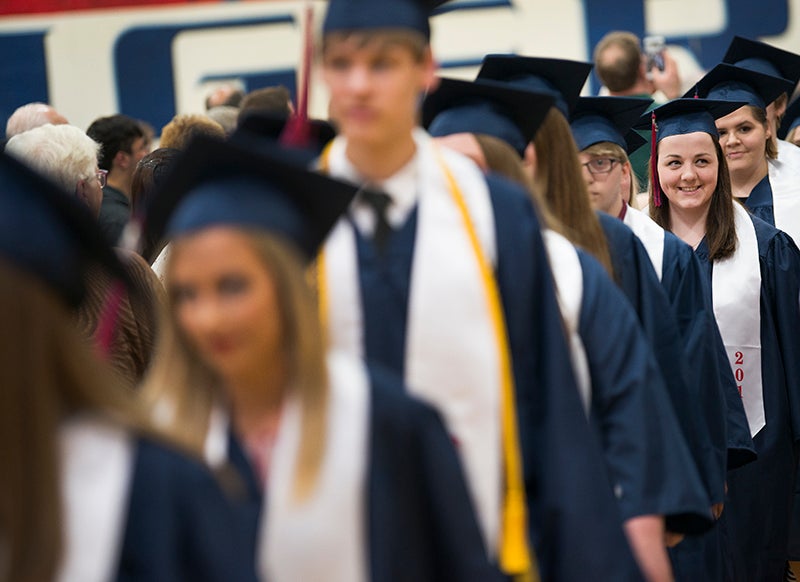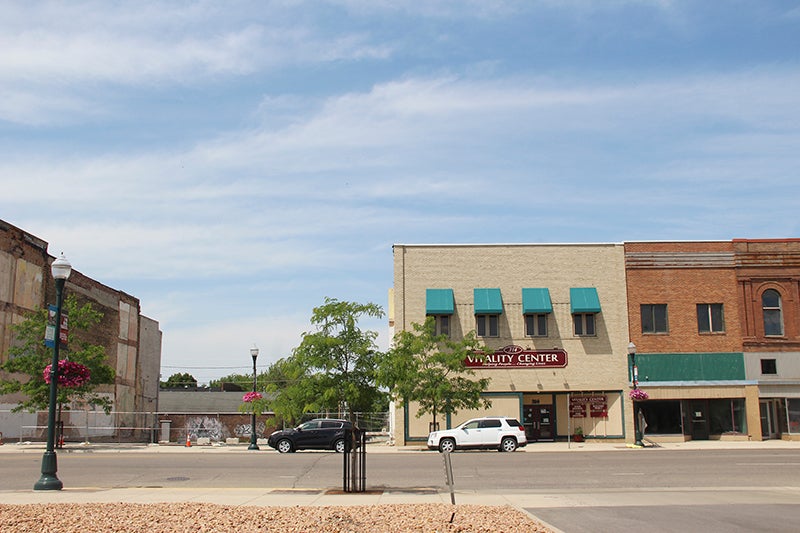A change in the trend
Published 8:12 pm Tuesday, April 23, 2019

- Albert Lea High School graduates walk into the gymnasium during the ceremony in 2018. - Colleen Harrison/Albert Lea Tribune
District sees drop in graduation rate after 2-year climb
The Albert Lea school district is a few more percentage points away from its graduation rate goal after data released Tuesday shows a drop in the graduation rate.
In 2018, the district’s overall graduation rate was 77.9%, while in 2017, 80.4% of students graduated.
“I think it’s disappointing,” Albert Lea High School Principal Mark Grossklaus said. “I’m disappointed that it dropped. I think we have to do a better job of looking into the details.”
The graduation rate reflects students who graduate in four years, Executive Director of Teaching and Learning Mary Jo Dorman said. Students who do not graduate in four years — those who drop out, take more years to graduate or those whom the district was not able to keep track of — are counted against the four-year rate as not having graduated. Those who may take more years to graduate could include English learners, students at the Area Learning Center and students who are part of the district’s Transition program for 18- to 21-year-olds.
Dorman said the district’s next step is to sit down as a team and analyze the graduation rates by demographics. Breakouts can include race, recipients of special education and students eligible for free or reduced-price meals.
“We look at all those different areas and see, ‘Where do we need more improvement? Where do we see some growth?’ and make sure we’re really planning as we continue to set our goals in meeting in those areas,” she said.
Grossklaus said looking into graduation numbers should also mean looking into the students who are placed in the unknown categories: Did that student transfer? Did they go out of state? The student is counted against the district’s graduation rate if the district does not know where they went, Grossklaus said.
The district’s trend now diverges from the state’s, which sees a graduation rate continuing to rise, the Minnesota Department of Education reported. This year, 83.2% of the graduating class earned their diplomas, the highest graduation rate on state record. This is a 0.5% increase from last year’s rate.
“Graduating high school is a critical step on every student’s path to find their own success,” Education Commissioner Mary Cathryn Ricker said in a press release. “In Minnesota, we do not give up on our students. Behind every single data point in this year’s historic graduation rate, I not only see the unique stories of individual students, but also the hard work that educators, administrators, coaches and families put into supporting the needs of our students so they could reach this important milestone.”
The state also saw increases in several demographic areas, including in American Indian/Alaska Native students, Asian students, Hispanic students, students identifying as two or more races, black students, English learners, students receiving special education services and students eligible for free or reduced-price meals.
In the Albert Lea district, graduation rates increased for Hispanic and Latino students, while it decreased for students eligible for free and reduced-price meals, students receiving special education services and English learners.
To Grossklaus, the Transition program creates what he called a Catch 22 for the district. While students are, by law, eligible to continue schooling based on their needs, they are counted against the district’s four-year graduation rate. The rate of students who graduate from special education is much higher, Grossklaus said; it is just not in four years.
The district’s four-year graduation rate for students receiving special education services is 56.3%. Its seven-year rate is 73.9%.
The percent of students graduating from the Albert Lea Area Learning Center also decreased slightly, from 53% to 52.7%.
While Dorman said the data does not always reflect it, the district is trying to figure out what it can do best for student growth. She said the district has hard-working teachers who are pushing children to be successful in their transition to adulthood. The four-year graduation rate is just one number that reflects work in the district, she said.
“I think we’re doing the right things,” Dorman said. “I think we’re really digging in.”
Both the school district and the state have a 90% graduation rate goal, though the state’s goal is to achieve that as a four-year percentage by 2020 and with no student group below 85%. The district’s goal does not specify a deadline or a four-year parameter.
According to the Minnesota Department of Education’s press release, the state plans to identify for support any public high school with a four-year graduation rate below 67% overall or for any student group.
Should that identification be based on Albert Lea’s graduation rates from 2018 — which show students receiving special education services and English learners at four-year graduation rates below 67% — Albert Lea High School would qualify.
“We recognize that the goal we set for 2020 was ambitious, and it must be,” Ricker said. “One Minnesota includes a commitment to support all our students to graduate.”
Albert Lea High School Principal Mark Grossklaus plans to put together a presentation for the school board with more information on the district’s findings as it analyzes its graduation rates from this year.
Area schools’ four-year graduation rates
Albert Lea: 77.9%
Alden-Conger: 100%
Austin: 76.1%
Glenville-Emmons: 87.5%
Owatonna: 83.3%
NRHEG: 81.3%
United South Central: 88.1%
Demographics breakdown: Albert Lea Area Schools
Albert Lea Area Schools
Total: 77.9% (233 students)
Students eligible for free or reduced-price meals: 68.4% (106 students)
SPED: 56.3% (27 students)
Hispanic or Latino: 76.7% (33 students)
ELL: 52.9% (9 students)
Asian: 66.7% (10 students)
Male: 72.8% (110 students)
Female: 83.1% (123 students)
Albert Lea Area Learning Center: 52.7% (39 students)





